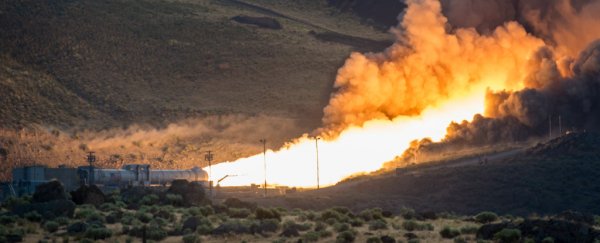NASA just passed a huge milestone in its mission to Mars, after conducting the final ground test of one of the boosters that'll power the Space Launch System (SLS) to the Red Planet.
It's the last trial of the system's boosters before the 2018 unmanned launch of the Orion spacecraft, and, as you can see from the footage below, everything looked really good lighting up the middle of the desert.
"This final qualification test of the booster system shows real progress in the development of the Space Launch System," said William Gerstenmaier, associate administrator for NASA's Human Exploration and Operations Mission Directorate.
"Seeing this test today, and experiencing the sound and feel of approximately 3.6 million pounds [1.6 million kg] of thrust, helps us appreciate the progress we're making to advance human exploration and open new frontiers for science and technology missions in deep space."
NASA hasn't yet released the full footage of the launch - which was running an hour behind schedule after computer issues - but you can enjoy the highlight below with these gifs made by Gizmodo:


And in our Snapchat story from the live test (username = sciencealert):
I'll just let those images sink in for a second here, because, guys, we're really going to Mars.
Well, not me, specifically, and probably not you, either. But some lucky humans out there will be boarding the SLS in the decades to come and riding towards humanity's future.
And if you think the power in that test is impressive, get ready, because the completed SLS will have two of these 70-tonne bad boys attached.
Once it's finished, the SLS will be the most powerful rocket ever built, and it'll be tasked with driving the Orion spacecraft - which will carry future Mars mission astronauts - to the Red Planet.
In the meantime, NASA has been testing the rocket piece by piece, with the first trial of the booster conducted last March.
That initial trial ran the booster for more than 2 minutes at the top end of its temperature range - 32 degrees Celsius (90 degrees Fahrenheit) - while this latest test took it down to the bottom end of its range, with the propellant cooled to a chilly 4 degrees Celsius (40 degrees Fahrenheit).
Even though the propellant was cold, the booster clearly worked the way it's supposed to, from a non-expert point of view at least, with temperatures inside the structure soaring to more than 3,100 degrees Celsius (6,000 degrees Fahrenheit), according to NASA.
NASA's engineers are now scrutinising data from the test, captured by more than 530 instruments on the booster, and will make sure that everything is functioning as it's supposed to.
Once all's said and done, these two boosters will together provide more than 75 percent of the thrust needed for the rocket and Orion to escape Earth's gravitational pull and make its way to Mars, and we can't wait to see them in action in 2018.
